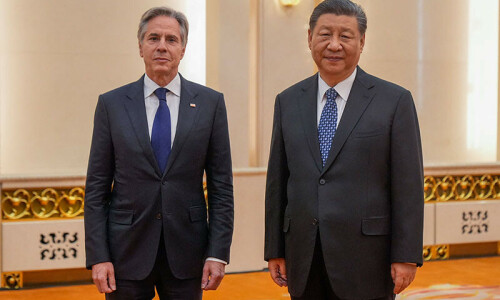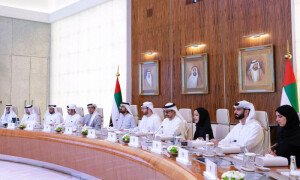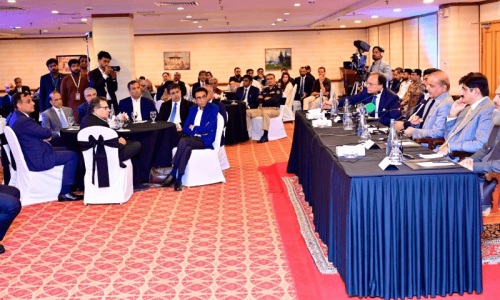PESHAWAR: The China-Pakistan Economic Corridor project is likely to take initial shape by 2020 and start boosting economic growth in both countries, suggests the multibillion dollars initiative’s draft long-term plan.
The federal government had recently shared the draft LTP with the provinces for feedback. The LTP will remain operative until 2030 after its approval by both Pakistan and China.
The draft LTP, a copy of which is available with Dawn, says the CPEC covers China’s Xinjiang Uyghur Autonomous Region and whole territory of Pakistan and its coverage is divided into core and radiation zones.
It says the core and radiation zones present the spatial layout of the ‘one belt, three axes and several passages’.
Draft document says security, geopolitical risks and restraints to economic growth prospects possible challenges to venture
“By one belt, we mean the belt area composed of core zone of CPEC including Kashgar, Tumshuq city, Atushi city and Atko county in Kizilsu Kirghiz autonomous prefecture of Xinjiang as well Islamabad, parts of Punjab, Sindh, Khyber Pakhtunkhwa, Balochistan, Azad Jammu and Kashmir, and Gilgit-Baltistan,” it reads.
On the other hand, three axes refer to three horizontal axes connecting Lahore and Peshawar, Sukkur and Quetta, and Karachi and Gwadar.
The CPEC is also divided into five functional zones from north to south.
The document mentions the geopolitical and security risks, restraints of natural and geographical factors and restraints to economic growth prospects as the possible challenges to this venture.
“China is responsible for planning, financing, building and operating projects within its territory and for those in Pakistan, both the countries shall jointly prepare plans, divide financing responsibilities based on project situation and their respective investment and financing strength,” it says.
The key cooperation areas identified in the document include transport, information network infrastructure, energy, industries and industrial parks, agriculture development and poverty alleviation, tourism and financial cooperation.
The plans for construction of integrated transport system include construction of Kashgar-Islamabad, Peshawar-Islamabad-Karachi, Sukkur-Gwadar Port and Dera Ismail Khan-Quetta-Sohrab Road infrastructure, capacity enhancement of existing railway lines and construction of new projects and construction and development of Gwadar port and port city.
In the information network sector, it envisages the construction of cross-border optical fiber cables between China and Pakistan and construction of backbone optical fiber cable networks in Pakistan, upgrading of Pakistan’s network facilities, including national data centre and second submarine cable landing station and to expedite Pakistan to adopt China’s Digital Terrestrial Multimedia Broadcasting standard.
The plans for the energy sector include research and cooperation development of oil and gas resources and conduct preliminary research on China-Pakistan oil and gas pipeline projects, optimise layout of imported coal and utilisation of Pakistan’s own coal for power plant and developing technologies for surface coal gasification.
In the industries and industrial park sector, the plans include expansion of the cooperation in appliance industry, promotion of local industries from assembling imported parts to localised production of parts and encouraging of various forms of Chinese enterprises to enter Pakistani market to improve the development of energy efficient appliance industry.
The tourism sector plans call for exploiting the potential tourism advantages of the border areas and construction of cross-border tourist routes along the railways and highways.
It also proposes the construction of tourism spatial structure in the Pakistan coastal belt, including two centers, one axis and five zones. Karachi and Gwadar ports would serve as two centers, while the coastal tourism belt as development axis and five tourist zones include Jiwani, Jiedijiao, Ormara, Sonmiani and Keti Bander.
The chapter about the investment and financing mechanism says the both countries bear the responsibility for investment and financing purely public welfare projects.
“The Pakistani federal government and provincial governments along the CPEC should try to assume some investment and financing responsibilities by various means, such as earmarked budget funds at all levels for the China-Pakistan Economic Corridor building and allowing provincial governments to issue financial bonds in domestic and foreign capital markets,” it reads.
Both countries also shall encourage Chinese enterprises, private sector, and private sector funds of the other economic entities to make various forms of direct investment, welcome Pakistan private capital in the participating in the CPEC projects.
It also says both countries welcome the World Bank, Asian Development Bank, Asian Infrastructure Bank and other international financial institutions to provide long-term concession loans to the support the investment and financing the projects along the CPEC.
Published in Dawn, May 12th, 2017














































Dear visitor, the comments section is undergoing an overhaul and will return soon.